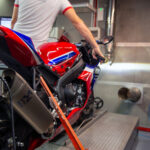Many cyclists obsess over having the latest, most aerodynamic bike, believing it’s the key to speed. However, the truth is that Bike Speed is far more dependent on the rider’s position than the bike itself. You, the rider, are the largest source of wind resistance when cycling.
In a wind tunnel test without a rider, the aerodynamic differences between a dedicated aero road bike and a time trial or triathlon bike would be minimal, if noticeable at all. This is especially true if both bikes are equipped with deep-section front wheels and rear disc wheels. The game changes dramatically when a rider is added to the equation.
Adopting a good aerobars position is significantly faster than a standard hoods or drops position. For endurance events like Ironman triathlons, the aerobars position offers another crucial advantage: comfort and sustainability over long distances. When using aerobars, your weight is supported by your skeletal structure on the arm pads, reducing muscular strain compared to holding yourself up in a hoods or drops position. Sustaining an aerodynamic hoods position for 112 miles, as in a full Ironman bike leg, is simply not feasible for most athletes.
While you can equip a road bike with aerobars, it’s often a compromise. Simply bolting aerobars onto a standard road bike setup won’t automatically create an optimal triathlon position. Your front end will likely be too high and not far enough forward, and your seat will be positioned too far back.
It’s possible to modify a road bike to better mimic a triathlon bike position. This can involve using a zero-offset seat post, slamming the saddle forward, installing a long stem, removing headset spacers, and potentially even using a negative angle stem to achieve a lower front end. Companies like Redshift offer components designed to make switching between road and triathlon positions easier on a road bike.
However, even with these modifications, a road bike adapted for triathlon is still a compromise. The bike’s geometry wasn’t originally designed for a triathlon position. Handling can become awkward due to the shifted weight distribution, and the standard road bike hand positions (hoods and drops) become less comfortable and accessible when the bike is set up for triathlon riding. Furthermore, maintaining aero position shifting can be an issue without electronic shifting and aero bar extensions.
For athletes with the budget and space, owning both a dedicated road bike and a dedicated triathlon bike is the ideal solution. This allows for optimized geometry and componentry for each discipline, which is why professional and serious amateur triathletes commonly choose this approach. Ultimately, to maximize bike speed, focus on optimizing your rider position first and foremost.

